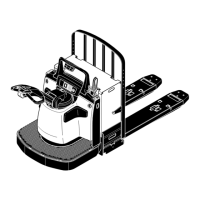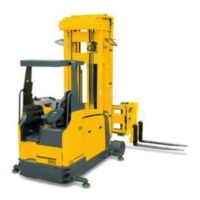03.11 EN
42
3 Starting up the truck
3.1 Checks and operations to be performed before starting daily
operation
WARNING!
Damage and other truck or attachment (special equipment) defects can result
in accidents.
If damage or other truck or attachment (special equipment) defects are discovered
during the following checks, the truck must be taken out of service until it has been
repaired.
XReport any defects immediately to your supervisor.
XTag out and decommission a faulty lift truck.
XOnly return the truck to service when you have identified and rectified the fault.
Pre-start inspections
Procedure
• Check the whole of the outside of the truck for signs of damage and leaks.
Damaged hoses must be replaced immediately.
• Check the battery attachment and wire connections for damage and make sure
they are secure.
• Check the battery connector is secure.
• Check the load handler for visible signs of damage such as cracks, bent or severely
worn forks.
• Check the drive wheel and load wheels for damage.
• Check that the markings and labels are present, clean and legible, (see
"Identification points and data plates" on page 21).
• Test the Emergency Disconnect switch.
• Check the control handle (damper) is restored to its normal position.
• Check the controls are automatically restored to zero after being applied.
• Test the warning signal.
• Test brakes.
• Test the collision safety switch.
03.11 EN
42
3 Starting up the truck
3.1 Checks and operations to be performed before starting daily
operation
WARNING!
Damage and other truck or attachment (special equipment) defects can result
in accidents.
If damage or other truck or attachment (special equipment) defects are discovered
during the following checks, the truck must be taken out of service until it has been
repaired.
XReport any defects immediately to your supervisor.
XTag out and decommission a faulty lift truck.
XOnly return the truck to service when you have identified and rectified the fault.
Pre-start inspections
Procedure
• Check the whole of the outside of the truck for signs of damage and leaks.
Damaged hoses must be replaced immediately.
• Check the battery attachment and wire connections for damage and make sure
they are secure.
• Check the battery connector is secure.
• Check the load handler for visible signs of damage such as cracks, bent or severely
worn forks.
• Check the drive wheel and load wheels for damage.
• Check that the markings and labels are present, clean and legible, (see
"Identification points and data plates" on page 21).
• Test the Emergency Disconnect switch.
• Check the control handle (damper) is restored to its normal position.
• Check the controls are automatically restored to zero after being applied.
• Test the warning signal.
• Test brakes.
• Test the collision safety switch.

